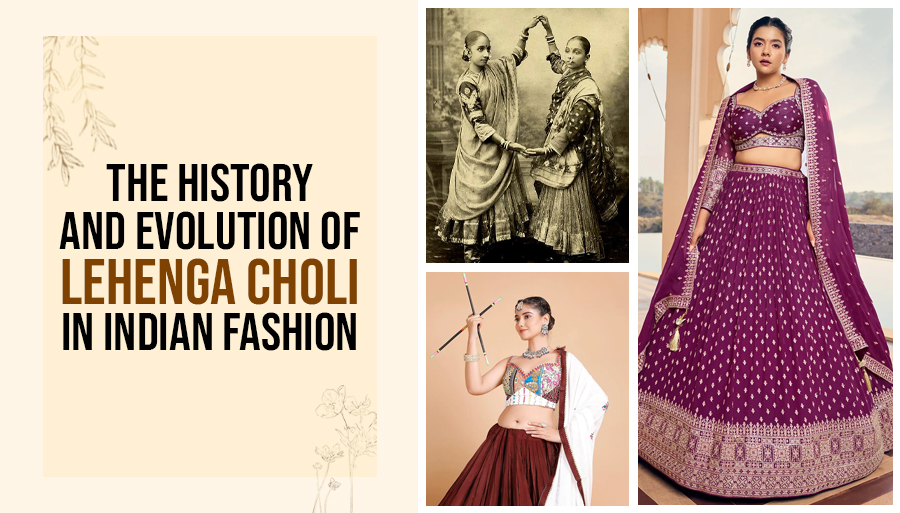The most popular outfit in India that is almost inseparable from the concept of Indian bride is the lehenga choli. India has traditionally combined the two different garments into the lehenga choli set for centuries.
This outfit redefines Indianness as Indian women resort to the long skirt and a blouse often during the most auspicious festivals of the country. The cloth hanging over the shoulders is referred to as a dupatta, and it has its origins from ancient India.
The History of Lehenga-Choli – from Mohenjo-daro to Mughal Times!
Chronological historical sources reveal that the lehenga choli was inspired from the indigenous civilization of Mohenjo-daro that existed around 2800 BC. Artful paintings provide evidence of both men and women wearing such garments in sculptures and paintings of this period. Women adorned outfits that resembled the contemporary lehenga choli, which has remained a constant feature to this day.
Thus, over centuries this outfit has developed, reflecting the tendencies and demands within diverse dress customs. The outfit has also embraced universal patterns and ethnic influences, reflecting the times and also the culture of the region to connote grace in the attire.
The middle age unleashed new versions for lehenga cholis for women and gained popularity among citizens. In the Mughal period (16th – 19th century), the outfit was popularized by royalty and the nobility. Lehenga choli now got embellished with elaborate designs and embroideries, beautiful fabrics, and fabulous techniques.
The embroidered garment signified the status and the wealth of the kings and the nobility, each intricately woven with gold and silver thread. They combined it with gems and elaborate patterns that were incorporated onto the cloth. This period also unleashed the gharara and sharara – variations of lehenga where instead of a skirt, wide-legged pants came into existence. These changes added to the list of conventional Indian clothing.
Beyond the Mughal period and into the 20th century
As India stepped into the modern era, the lehenga choli also underwent certain changes which were inspired by the changing trends of dressing and fashion. In the 20th century, the attire supplemented some elements of the tradition with contemporary designs.
Bollywood movies and actresses dictated new trends of wearing lehenga choli on screen. This period also inspired Indian fashion designers to imitate and twist the cuts, silhouettes, and fabrics with traditional style with aplomb.
How the Lehenga Choli has Changed Today!
Today, the lehenga choli continues to be one of the most beautiful ethnic Indian dresses that have sneaked into the modern world by aligning with stylish trendy patterns.
Here’s how:
- Designers have started using unconventional fabrics such as leather, denim and the like
- They now choose eco-friendly fabrics to design the lehenga choli.
- The cut also escaped controversy and became popular, now evolving into a simple pattern that evokes the image of an erstwhile princess.
- Laces have not been left behind either as designers have resorted to 3D embroidery mirror work today.
Due to this blend of traditional and trendy designs, the lehenga choli has become a trendy attire, which continues to be worn during weddings, parties, red carpet events, and the like.
Lehenga Choli – Making a Global Appeal in an Eco-Friendly Manner
Women from across the globe are donning it with style and vigour. Celebrities and fashion divas endorse designer Lehenga Cholis regularly and driven its popularity to the skies. These outfits now sport both Indian and Western designs intricately, lending the global nature of the lehenga choli fashion. Global bridal fashion with non-India brides now choose to use lehenga cholis on their wedding day, relating to the tradition and culture behind the same.
One of the defining features of the lehenga choli is that though it has evolved into a modern attire, it has not strayed far from its roots. Eco-friendliness in the fashion industry has now seeped into the new designs of lehenga choli, ensuring wider use of organic fabrics, naturally-sourced colours, and recycled products while sewing outfits.
Fashion designers have restarted conventional weaving practices of carpets and fabrics and extending their support for Indian weavers, to retain their traditional expertise. The evolution of lehenga choli from the olden days to today’s modern times reveals its inherent sustainability.
As the future beckons, this traditional Indian garment continues to rule people’s hearts, making a statement piece rise high in the volatile fashion world merging ethnic wear with modern fashion.

